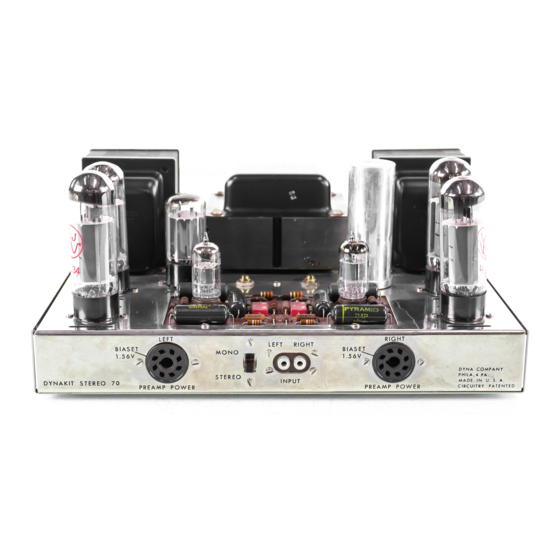DYNACO Stereo 70 Manual de restauración - Página 4
Navegue en línea o descargue pdf Manual de restauración para Amplificador DYNACO Stereo 70. DYNACO Stereo 70 20 páginas. Series ii tube amplifier
También para DYNACO Stereo 70: Manual de restauración (5 páginas), Manual del usuario (12 páginas), Instrucciones de montaje (16 páginas)

Dynaco Stereo 70 Power Amplifier
Restoration Manual
Detailed Procedure & Guide
Page 4
R0 4-03
grid will fall to zero volts and at this point the tubes will conduct way too much
current causing the familiar glowing red plate elements (from the heat).
Eventually the fuse will trip or, if too late, the tubes will be destroyed. The
negative voltage needed to keep the tubes conducting the desired current is
produced in the bias supply (located in the power supply section) and is delivered
to the control grid (pin 5) via the tube socket. Therefore should the tube socket
corrode or otherwise fail to connect to the tube control grid pin (5), the voltage
appearing at the control grid (pin 5) will fall to zero causing the tube to conduct
excessive (and destructive) current. You may want to think of the negative control
grid voltage as the adjustable safety valve. Because each tube differs from unit to
unit, it is necessary to make this voltage variable and user adjustable. This
adjustment is made via the BIAS ADJUSTMENT pots (located on the amp
between the rectifier tube and Quad filter capacitor). As the user adjusts the
voltage on the control grid, the current flowing through the tube (from plate to
cathode) flows into the Cathode Bias Resistor (the 15.6 ohm resistor discussed
above) causing a voltage drop to appear across this resistor (via ohms law). The
user then measures the voltage across the resistor as an indicator of the current
flowing through the tube (via ohms law Voltage = Current X Resistance). Since
the current flowing through each tube should be about 50mA, and since both
tubes (in one channel) have their cathode current flowing through a single
common Bias Resistor, the total current through the bias resistor will total 2X
50mA, or 100mA. By Ohms law, 100mA X 15.6 ohms = 1.56 Volts (DC) – and
this is the Bias Voltage specified by Dynaco. Failures in the output section usually
manifest themselves as bias difficulties (too much or too little) usually the result
of problems in the bias supply, weak or shorted tubes, defective tube sockets
(loose or corroded terminals), or (rarely) defective output transformers.
3) The Driver Amplifier & Phase Splitter – This is perhaps the most complex part
of the Stereo 70 power amplifier. It is the 7" X 4 " (approximate) PC board
located in the front center of the amp between the two pairs of output tubes. It
houses two identical channels each consisting of a 7199 signal tube and associated
resistors and signal capacitors. The 7199 contains two sections – the pentode
section (where the input signal from your preamp is initially amplified), and a
triode section where the signal is split into two equal, but out of phase signals (out
of phase means that one signal is the mirror image of the other). For push pull
amplifiers (like the Stereo 70) it is necessary to deliver two out of phase signals to
the output section. Failures in the driver section usually manifest themselves as
differences in channel level, distortion, buzzes, crackles, hissing, or other
disharmonious sounds. Most often the problem appears in only in one channel.
The signal from the driver board circuit is sent to each of the four output tubes
(individually) via a coupling capacitor (0.1uF). Note that the voltage on the driver
side of the coupling capacitor is at hundreds of volts (positive) and the voltage at
the output tube side of the coupling capacitor is at the output tube control grid's
(pin 5) negative voltage. If the capacitor becomes only moderately leaky, current
4
